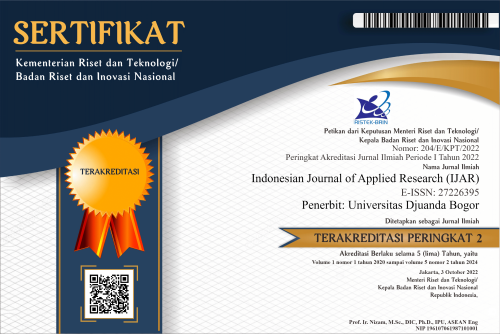The Potential Inhibition of Xanthine Oxidase by Phenolic and Flavonoids Date (Phoenix dactylifera) with Molecular Docking Method
Abstract
Dates is fruit of palm trees that mostly grow in the Middle East. Dates contain phenolic acids and flavonoids that have antioxidants and potentially inhibit the ability of xanthine oxidase. The purpose of this research to determine the molecular interactions of xanthine oxidase by ligand of phenolic acids and flavonoids to inhibiting the production of uric acid. This research was conducted by site directed docking method. The size of the center of retardation used in this research is x = 26.569, y = 9.985, and z = 113.088 and the retardation volume of x = 14, y = 14, and z = 16. Inhibition by flavonoid and phenolic acid compounds has produces good inhibition strength shown by Gibbs free energy which is negative. The compound with the highest Gibbs free energy value is the anthocyanins compound which is -7.3 kCal / mol, the value is higher than the comparator ligand, allopurinol. Based on the bond analysis that is formed, the best compound in inhibiting xanthine oxidase is syringic acid.
References
Al-Shwyeh, H. A. “Date Palm (Phoenix dactylifera L.) Fruit as Potential Antioxidant and Antimicrobial Agents.” Journal of pharmacy & bioallied science 11,1 (2019): 1-11. doi:10.4103/jpbs.JPBS_168_18.
Cao, H., Pauff, J. M., & Hille, R. (2010). Substrate orientation and catalytic specificity in the action of xanthine oxidase: The sequential hydroxylation of hypoxanthine to uric acid. The Journal of Biological Chemistry, 285(36), 28044–28053. https://doi.org/10.1074/jbc.M110.128561
Echegaray, N., Pateiro, M., Gullón, B., Amarowicz, R., Misihairabgwi, J., & Lorenzo, J. M. (2020). Phoenix dactylifera products in human health – A review. Trends in Food Science & Technology, 105, 238–250. https://doi.org/10.1016/j.tifs.2020.09.017
Enroth, C., Eger, B. T., Okamoto, K., Nishino, T., Nishino, T., & Pai, E. F. (2000). Crystal structures of bovine milk xanthine dehydrogenase and xanthine oxidase: Structure-based mechanism of conversion. Proceedings of the National Academy of Sciences of the United States of America, 97(20), 10723–10728. https://doi.org/10.1073/pnas.97.20.10723
Ferdian, P. (2016). Potensi senyawa asam lemak rantai pendek sebagai aktivator langsung AMPK secara in silico untuk terapi sindrom metabolic. Institut Pertanian Bogor.
Hidayat, R. (2007). Kinetika inhibisi flavonoid dalam sidaguri (Sida rhombifolia L.) terhadap aktivitas enzim xantin oksidase. Fakultas Matematika dan Ilmu Pengetahuan Alam, Institut Pertanian Bogor.
Ho, B. K., & Brasseur, R. (2005). The Ramachandran plots of glycine and pre-proline. BMC Structural Biology, 5(1), 14. https://doi.org/10.1186/1472-6807-5-14
Khairunnisa. (2013). Aktivitas inhibisi xantin oksidase oleh ekstrak air dan etanol anting-anting (Acalypha indica L.). Fakultas Matematika dan Ilmu Pengetahuan Alam, Institut Pertanian Bogor.
Leopoldini, M., Marino, T., Russo, N., & Toscano, M. (2004). Antioxidant Properties of Phenolic Compounds: H-Atom versus Electron Transfer Mechanism. The Journal of Physical Chemistry A, 108, 4916–4922. https://doi.org/10.1021/jp037247d
Lipinski, C. A. (2004). Lead- and drug-like compounds: The rule-of-five revolution. Drug Discovery Today: Technologies, 1(4), 337–341. https://doi.org/10.1016/j.ddtec.2004.11.007
Lu, H.-M., Yin, D.-C., Ye, Y.-J., Luo, H.-M., Geng, L.-Q., Li, H.-S., Guo, W.-H., & Shang, P. (2009). Correlation between protein sequence similarity and x-ray diffraction quality in the protein data bank. Protein and Peptide Letters, 16(1), 50–55. https://doi.org/10.2174/092986609787049457
Murata, K., Nakao, K., Hirata, N., Namba, K., Nomi, T., Kitamura, Y., Moriyama, K., Shintani, T., Iinuma, M., & Matsuda, H. (2009). Hydroxychavicol: A potent xanthine oxidase inhibitor obtained from the leaves of betel, Piper betle. Journal of Natural Medicines, 63(3), 355–359. https://doi.org/10.1007/s11418-009-0331-y
Murray, R., Bender, D., Botham, K., Kennely, P., Rodwell, V., & Weil, P. (2012). Biokimia Harper (29th ed.). EGC.
Ramachandran, G. N., Ramakrishnan, C., & Sasisekharan, V. (1963). Stereochemistry of polypeptide chain configurations. Journal of Molecular Biology, 7, 95–99. https://doi.org/10.1016/s0022-2836(63)80023-6
Sharma, N. K., & Jha, K. K. (2010). Molecular docking: An overview. J. Adv. Sci. Res, 1(1), 67–72.
Siahpoosh, A., Asili, J., & Sarhangi, B. (2016). Antioxidative and free radical scavenging activities of some extracts from ripe friuts of Phoenix dactylifera L. 8, 1735–1741.
Syahputra, G., Ambarsari, L., & Sumaryada, T. (2014). Simulasi docking kurkumin enol, bisdemetoksikurkumin dan analognya sebagai inhibitor enzim12- lipoksigenase. Jurnal Biofisika, 10(1), 55–67.
Trott, O., & Olson, A. J. (2010). AutoDock Vina: Improving the speed and accuracy of docking with a new scoring function, efficient optimization, and multithreading. Journal of Computational Chemistry, 31(2), 455–461. https://doi.org/10.1002/jcc.21334
Umamaheswari, M., Madeswaran, A., Asokkumar, K., Sivashanmugam, T., Subhadradevi, V., & Jagannath, P. (2011). Discovery of potential xanthine oxidase inhibitors using in silico docking studies. Der Pharma Chemica, 3(5), 240–247.
Wan Ismail, W. I. (2013). Evaluation on the Benefits of Date Palm (Phoenix dactylifera) to the Brain. Alternative & Integrative Medicine, 02. https://doi.org/10.4172/2327-5162.1000115
Copyright (c) 2021 Indonesian Journal of Applied Research

This work is licensed under a Creative Commons Attribution-ShareAlike 4.0 International License.
The Authors submitting a manuscript do so on the understanding that if accepted for publication, copyright publishing of the article shall be assigned/transferred to Indonesian Journal of Applied Research (IJAR) Universitas Djuanda as Publisher of the journal. Upon acceptance of an article, authors will be asked to complete a 'Copyright Transfer Agreement'. An e-mail will be sent to the corresponding author confirming receipt of the manuscript together with a 'Copyright Transfer Agreement' form by online version of this agreement.
Indonesian Journal of Applied Research (IJAR) Universitas Djuanda, the Editors and the Editorial Board make every effort to ensure that no wrong or misleading data, opinions or statements be published in the journal. In any way, the contents of the articles and advertisements published in the Indonesian Journal of Applied Research (IJAR) Universitas Djuanda are sole and exclusive responsibility of their respective authors and advertisers.
Remember, even though we ask for a transfer of copyright, our journal authors retain (or are granted back) significant scholarly rights as mention before.
The Copyright Transfer Agreement (CTA) Form can be downloaded here: Copyright Transfer Agreement-IJAR 2020
The copyright form should be signed electronically and send to the Editorial Office e-mail below:
Prof. Dr. Ir. Dede Kardaya, M.Si. (Editor-in-Chief)
Universitas Djuanda
Jl. Tol Jagorawi No.1, Ciawi, Kec. Ciawi, Bogor, Jawa Barat 16720
Website: http://journal.unida.ac.id/index.php/IJAR/index
Email: ijar@unida.ac.id






 This work is licensed under a
This work is licensed under a 